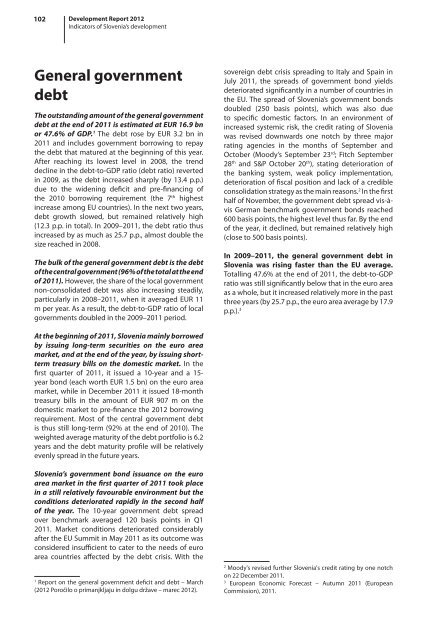development report 2012 - UMAR
development report 2012 - UMAR
development report 2012 - UMAR
Create successful ePaper yourself
Turn your PDF publications into a flip-book with our unique Google optimized e-Paper software.
102 Development Report <strong>2012</strong><br />
Indicators of Slovenia’s <strong>development</strong><br />
General government<br />
debt<br />
The outstanding amount of the general government<br />
debt at the end of 2011 is estimated at EUR 16.9 bn<br />
or 47.6% of GDP. 1 The debt rose by EUR 3.2 bn in<br />
2011 and includes government borrowing to repay<br />
the debt that matured at the beginning of this year.<br />
After reaching its lowest level in 2008, the trend<br />
decline in the debt-to-GDP ratio (debt ratio) reverted<br />
in 2009, as the debt increased sharply (by 13.4 p.p.)<br />
due to the widening deficit and pre-financing of<br />
the 2010 borrowing requirement (the 7 th highest<br />
increase among EU countries). In the next two years,<br />
debt growth slowed, but remained relatively high<br />
(12.3 p.p. in total). In 2009–2011, the debt ratio thus<br />
increased by as much as 25.7 p.p., almost double the<br />
size reached in 2008.<br />
The bulk of the general government debt is the debt<br />
of the central government (96% of the total at the end<br />
of 2011). However, the share of the local government<br />
non-consolidated debt was also increasing steadily,<br />
particularly in 2008–2011, when it averaged EUR 11<br />
m per year. As a result, the debt-to-GDP ratio of local<br />
governments doubled in the 2009–2011 period.<br />
sovereign debt crisis spreading to Italy and Spain in<br />
July 2011, the spreads of government bond yields<br />
deteriorated significantly in a number of countries in<br />
the EU. The spread of Slovenia’s government bonds<br />
doubled (250 basis points), which was also due<br />
to specific domestic factors. In an environment of<br />
increased systemic risk, the credit rating of Slovenia<br />
was revised downwards one notch by three major<br />
rating agencies in the months of September and<br />
October (Moody’s September 23 rd ; Fitch September<br />
28 th and S&P October 20 th ), stating deterioration of<br />
the banking system, weak policy implementation,<br />
deterioration of fiscal position and lack of a credible<br />
consolidation strategy as the main reasons. 2 In the first<br />
half of November, the government debt spread vis-àvis<br />
German benchmark government bonds reached<br />
600 basis points, the highest level thus far. By the end<br />
of the year, it declined, but remained relatively high<br />
(close to 500 basis points).<br />
In 2009–2011, the general government debt in<br />
Slovenia was rising faster than the EU average.<br />
Totalling 47.6% at the end of 2011, the debt-to-GDP<br />
ratio was still significantly below that in the euro area<br />
as a whole, but it increased relatively more in the past<br />
three years (by 25.7 p.p., the euro area average by 17.9<br />
p.p.). 3<br />
At the beginning of 2011, Slovenia mainly borrowed<br />
by issuing long-term securities on the euro area<br />
market, and at the end of the year, by issuing shortterm<br />
treasury bills on the domestic market. In the<br />
first quarter of 2011, it issued a 10-year and a 15-<br />
year bond (each worth EUR 1.5 bn) on the euro area<br />
market, while in December 2011 it issued 18-month<br />
treasury bills in the amount of EUR 907 m on the<br />
domestic market to pre-finance the <strong>2012</strong> borrowing<br />
requirement. Most of the central government debt<br />
is thus still long-term (92% at the end of 2010). The<br />
weighted average maturity of the debt portfolio is 6.2<br />
years and the debt maturity profile will be relatively<br />
evenly spread in the future years.<br />
Slovenia’s government bond issuance on the euro<br />
area market in the first quarter of 2011 took place<br />
in a still relatively favourable environment but the<br />
conditions deteriorated rapidly in the second half<br />
of the year. The 10-year government debt spread<br />
over benchmark averaged 120 basis points in Q1<br />
2011. Market conditions deteriorated considerably<br />
after the EU Summit in May 2011 as its outcome was<br />
considered insufficient to cater to the needs of euro<br />
area countries affected by the debt crisis. With the<br />
1<br />
Report on the general government deficit and debt – March<br />
(<strong>2012</strong> Poročilo o primanjkljaju in dolgu države – marec <strong>2012</strong>).<br />
2<br />
Moody's revised further Slovenia's credit rating by one notch<br />
on 22 December 2011.<br />
3<br />
European Economic Forecast – Autumn 2011 (European<br />
Commission), 2011.
















